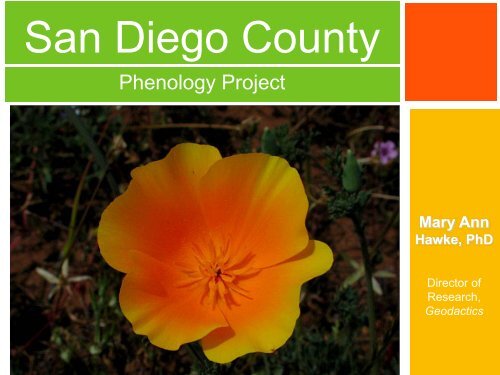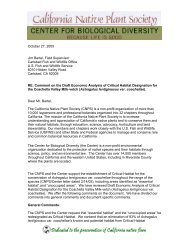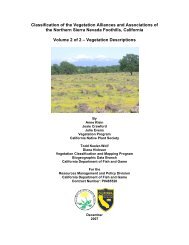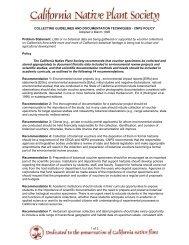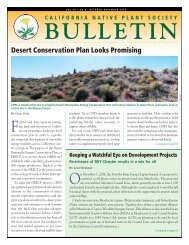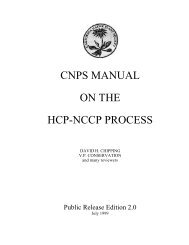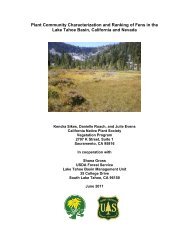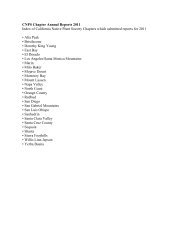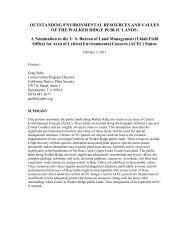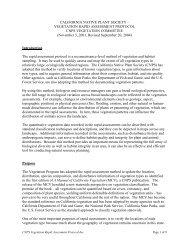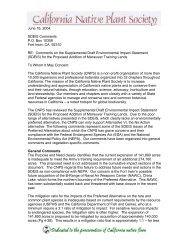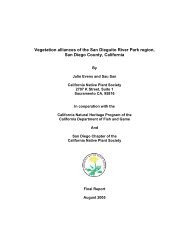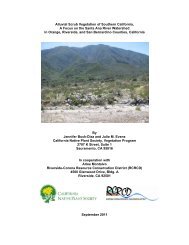Mary Anne Hawke: "The San Diego Phenology Project" - California ...
Mary Anne Hawke: "The San Diego Phenology Project" - California ...
Mary Anne Hawke: "The San Diego Phenology Project" - California ...
You also want an ePaper? Increase the reach of your titles
YUMPU automatically turns print PDFs into web optimized ePapers that Google loves.
<strong>San</strong> <strong>Diego</strong> County<br />
<strong>Phenology</strong> Project<br />
<strong>Mary</strong> Ann<br />
<strong>Hawke</strong>, PhD<br />
Director of<br />
Research,<br />
Geodactics
<strong>The</strong> Future<br />
Number of days >100 degrees F<br />
actually recorded<br />
for 1961-1979<br />
Number of >100F days predicted<br />
by the IPCC hi emission scenario<br />
for 2080-2099<br />
Source: Sierra magazine, Sept/Oct 2011 pg.18 www.sierraclub.org/sierra/201109/grapple2.aspx
Climate Change Here<br />
•<br />
<strong>The</strong> Chula<br />
Vista weather<br />
station shows a<br />
5 o F increase
<strong>Phenology</strong> and Climate
<strong>The</strong> Issue<br />
• Flowering plants provide<br />
convincing evidence of a response<br />
to global warming<br />
• Disruption of the synchrony<br />
between the timing of flowering<br />
and activity of insect pollinators (or<br />
migrating birds) is a serious<br />
concern<br />
• Studies that have been successful<br />
elsewhere, have not yet been tried<br />
here in our Mediterranean climate
Relevant Studies<br />
• Primack et al. (2004)<br />
• Compared flowering time of<br />
plants growing at the Arnold<br />
Arboretum in Boston, MA<br />
with 372 historic records of<br />
the same plants.<br />
• Boston experienced a 1.5°C<br />
increase in mean annual<br />
temperature since 1885.<br />
• <strong>The</strong> study shows that the<br />
plants studied are flowering<br />
8 days earlier as a response<br />
to changing temperatures
<strong>The</strong> Questions<br />
Are <strong>San</strong> <strong>Diego</strong> County plants responding to<br />
climate change Answer: we don’t know!<br />
Which plants are showing a strong, measurable<br />
phenological response<br />
What is the baseline against<br />
which we can measure change<br />
How should we focus future<br />
monitoring efforts<br />
Solving the puzzle requires adequate, local, scientific records<br />
that go back in time
Specimen Collections<br />
Plant Specimens Are<br />
Snapshots of our Past<br />
<strong>The</strong>re are over 60,000 plant<br />
specimens from <strong>San</strong> <strong>Diego</strong><br />
County in the SD Herbarium<br />
collection dating to the 1800s.
<strong>San</strong> <strong>Diego</strong> Collections<br />
• 92,252 records collected<br />
in SD County<br />
• 48,198 in SD Herbarium<br />
• 9,000 Plant Atlas<br />
specimens<br />
• 33,256 from Consortium<br />
of <strong>California</strong> Herbaria<br />
• Most have now been<br />
georeferenced<br />
CCH<br />
36%<br />
SD Plant Atlas<br />
11%<br />
SD Herbarium<br />
53%
Using Plant Specimens to<br />
Assess Climate Change<br />
• <strong>The</strong> extensive collection<br />
of historic plant<br />
specimens from <strong>San</strong><br />
<strong>Diego</strong> County in the SD<br />
Herbarium was examined,<br />
to investigate plant<br />
responses to regional<br />
climate change.<br />
Ceanothus verrucosus voucher<br />
specimen collected in 1935
Plants and Climate Change<br />
• Capture and analyze all available<br />
records of herbarium specimens<br />
collected from <strong>San</strong> <strong>Diego</strong> County
Seeing Climate through the Lives of<br />
Plants: Using Herbarium Specimen Data to<br />
Assess Climate Change in <strong>San</strong> <strong>Diego</strong> County<br />
Jeannie Gregory<br />
<strong>Mary</strong> Ann <strong>Hawke</strong>, Layla Aerne Hains, <strong>Anne</strong> Fege<br />
Funded by <strong>The</strong> Blasker-Rose-Miah Fund<br />
of <strong>The</strong> <strong>San</strong> <strong>Diego</strong> Foundation
Plants as Bioindicators of Climate Change<br />
Flowering plants provide convincing evidence of a response to<br />
global climate change<br />
Disruption in synchrony of the timing of flowering and insects or<br />
birds may be a serious concern<br />
Are <strong>San</strong> <strong>Diego</strong> County plants<br />
responding to climate change<br />
Which plants are showing a<br />
clear, measurable response<br />
Do the results of other studies<br />
apply in Mediterranean climates<br />
Can this help focus future<br />
monitoring efforts<br />
<strong>Mary</strong> Ann <strong>Hawke</strong> Ph.D<br />
Funded by <strong>The</strong> Blasker-Rose-Miah Fund of <strong>The</strong> <strong>San</strong> <strong>Diego</strong> Foundation
Methods: Use Herbarium Data to Study<br />
Phenological Trends in <strong>San</strong> <strong>Diego</strong><br />
Compile plant specimen data; Obtain weather station data<br />
Over 2282 plant species (1824 native); Screen out target spp.<br />
Graph flowering trends over time<br />
Statistically analyze for trends and relationship to weather data<br />
Identify species that show clear responses to climate (for future<br />
monitoring)<br />
Assumptions: 1) Target species to screen; 2) Weather station<br />
data already analyzed; 3) Plant data sufficient and consistent
Implications<br />
Flowering plants play an essential role in local ecology – knowing<br />
which ones to track into the future is key<br />
Disruption in synchrony of phenological events may seriously<br />
impact ecological systems – knowing the keystone species in <strong>San</strong><br />
<strong>Diego</strong> and more about linkages is required<br />
Deciding where to best invest monitoring $$ is wise (legal drivers<br />
do not necessarily point us to the most effective bioindicators)<br />
More work is needed! Including a local phenology network<br />
Phacelia<br />
Indian Paintbrush<br />
Chocolate Lily
Preliminary Findings<br />
Delphinium cardinale (Ranunculaceae)<br />
Scarlet Larkspur<br />
Monthly Temperature (F) at <strong>San</strong> <strong>Diego</strong> WSO Airport<br />
Delphinium cardinale<br />
75<br />
260<br />
70<br />
Mean = 69.87 F<br />
240<br />
220<br />
Temperature (F)<br />
65<br />
60<br />
Mean = 63.17 F<br />
Day of Year<br />
200<br />
180<br />
160<br />
140<br />
55<br />
50<br />
1900 1920 1940 1960 1980 2000 2020<br />
Year<br />
T Max<br />
Mean<br />
T Min<br />
Mean<br />
T Avg<br />
Mean<br />
Mean = 56.47 F<br />
120<br />
100<br />
1860 1880 1900 1920 1940 1960 1980 2000 2020<br />
Year<br />
Delphinium cardinale<br />
Monthly Total Precipitation at <strong>San</strong> <strong>Diego</strong> WSO Airport<br />
30<br />
Precipitation (inches)<br />
25<br />
20<br />
15<br />
10<br />
Mean = 10.15 inches<br />
6<br />
Deviation from Average Temp of 63.17F<br />
at <strong>San</strong> <strong>Diego</strong> WSO Airport<br />
Frequency<br />
30 60 90 120 150 180 210 240 270 300 330 360<br />
5<br />
0<br />
1900 1920 1940 1960 1980 2000 2020<br />
Monthly Precipitation Total<br />
Precipitation Mean<br />
Year<br />
Deviation from Average Temp<br />
4<br />
2<br />
0<br />
-2<br />
-4<br />
Day of Year<br />
-6<br />
1910 1920 1930 1940 1950 1960 1970 1980 1990 2000 2010<br />
Year<br />
Project webpage at www.sdnhm.org/climatechange
Communicating Climate<br />
• Involves 12 science centers across the US<br />
• Focuses on local indicators of climate change in each<br />
community<br />
• Fosters innovative partnerships between research centers,<br />
the media, and science centers (Reuben H. Fleet)<br />
• See www.rhfleet.org/c3<br />
Change (C3)<br />
Ken Bowles
Citizen Science<br />
• Project Budburst is a national field campaign for<br />
citizen scientists to report phenological changes of<br />
trees, shrubs, flowers, and grasses.<br />
• <strong>The</strong> USA National <strong>Phenology</strong> Network (NPN)<br />
monitors the influence of climate on the phenology<br />
of plants, animals, and landscapes and provides a<br />
place for the storage and sharing of observations.<br />
www.usanpn.org
Plants to Monitor in SD<br />
Evergreen Shrubs<br />
Big Sagebrush Artemisia tridentata Asteraceae<br />
Brittlebush Encelia farinosa var. farinosa Asteraceae<br />
Purple-eyed Encienso Encelia farinosa var. phenicodonta Asteraceae<br />
Broom Baccharis Baccharis sarothroides Asteraceae<br />
<strong>California</strong> Encelia Encelia californica Asteraceae<br />
Chamise Adenostoma fasciculatum Asteraceae<br />
Coast CA Buckwheat Eriogonum fasciculatum var. fasciculatum Polygonaceae<br />
Inland CA Buckwheat Eriogonum fasciculatum var. foliolosum Polygonaceae<br />
Coastal Deerweed Lotus scoparius var. scoparius Fabaceae<br />
Coastal Sagebrush Artemisia californica Asteraceae<br />
Honey Mesquite Prosopis glandulosa var. torreyana Fabaceae<br />
Laurel Sumac Malosma laurina Anacardiaceae<br />
Lemonadeberry Rhus integrifolia Anacardiaceae<br />
Mohave Yucca Yucca schidigera Agavaceae<br />
Parish's Goldenbush Ericameria parishii Asteraceae<br />
SD Monkey Flower Mimulus aurantiacus Phrymaceae<br />
Spreading Goldenbush Isocoma menziesii var. menziesii<br />
Asteraceae<br />
Toyon Heteromeles arbutifolia Rosaceae
Plants to Monitor in SD<br />
Deciduous Shrubs<br />
Blue Elderberry Sambucus mexicana (Sambucus nigra) Adoxaceae<br />
Ocotillo Fouquieria splendens ssp. splendens Fouquieriaceae<br />
Western Choke Cherry Prunus virginiana var. demissa Rosaceae<br />
Herbs<br />
Blue Dicks Dichelostemma capitatum ssp. capitatum <strong>The</strong>midaceae<br />
Few-Flowered Blue Dicks Dichelostemma capitatum ssp. pauciflorum <strong>The</strong>midaceae<br />
Desert Lily Hesperocallis undulata Liliaceae<br />
Western Ragweed * Ambrosia psilostachya Asteraceae<br />
Wild Turnip Brassica tournefortii Brassicaceae<br />
Yarrow Achillea millefolium Asteraceae<br />
Common Dandelion * Taraxacum officinale Asteraceae<br />
Wild Cucumber Marah macrocarpus Cucurbitaceae<br />
<strong>California</strong> Poppy Eschscholzia californica Papaveraceae<br />
* National <strong>Phenology</strong> Network Calibration Species
Plant Profiles
Contacts<br />
• <strong>Mary</strong> Ann <strong>Hawke</strong> - Geodactics at<br />
hawkema@gmail.com<br />
• Debbie DeRoma - RH Fleet at<br />
ddroma@rhfleet.org<br />
• Reuben H. Fleet Science Center,<br />
Communicating Climate Change (C3)<br />
www.rhfleet.org/c3<br />
• Search for <strong>San</strong> <strong>Diego</strong> County<br />
<strong>Phenology</strong> Project on Facebook
Thank you!<br />
• Resources<br />
• www.sdnhm.org/climatechange<br />
• www.geodactics.org<br />
• www.rhfleet.org/c3/<br />
• www.usanpn.org


